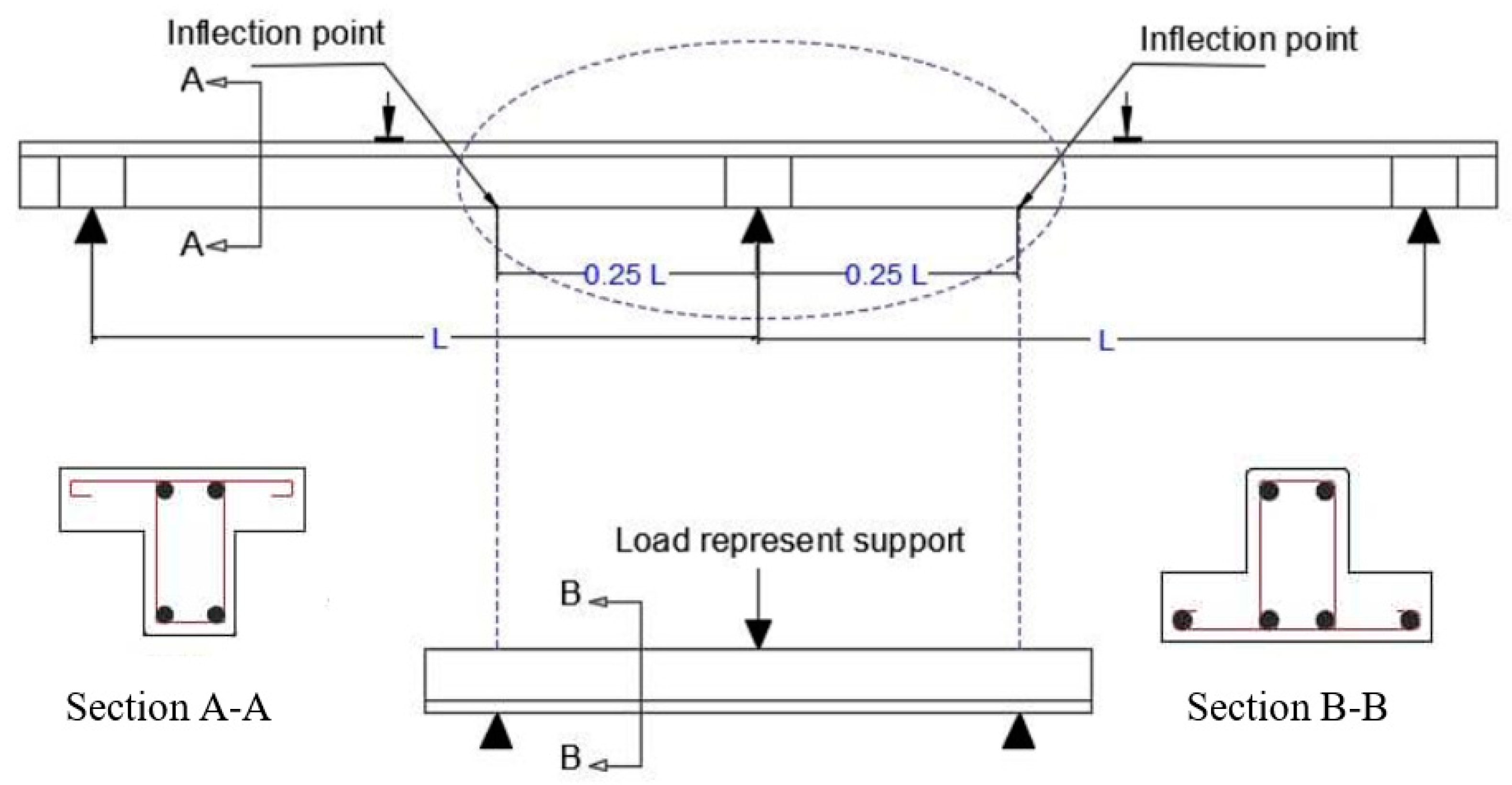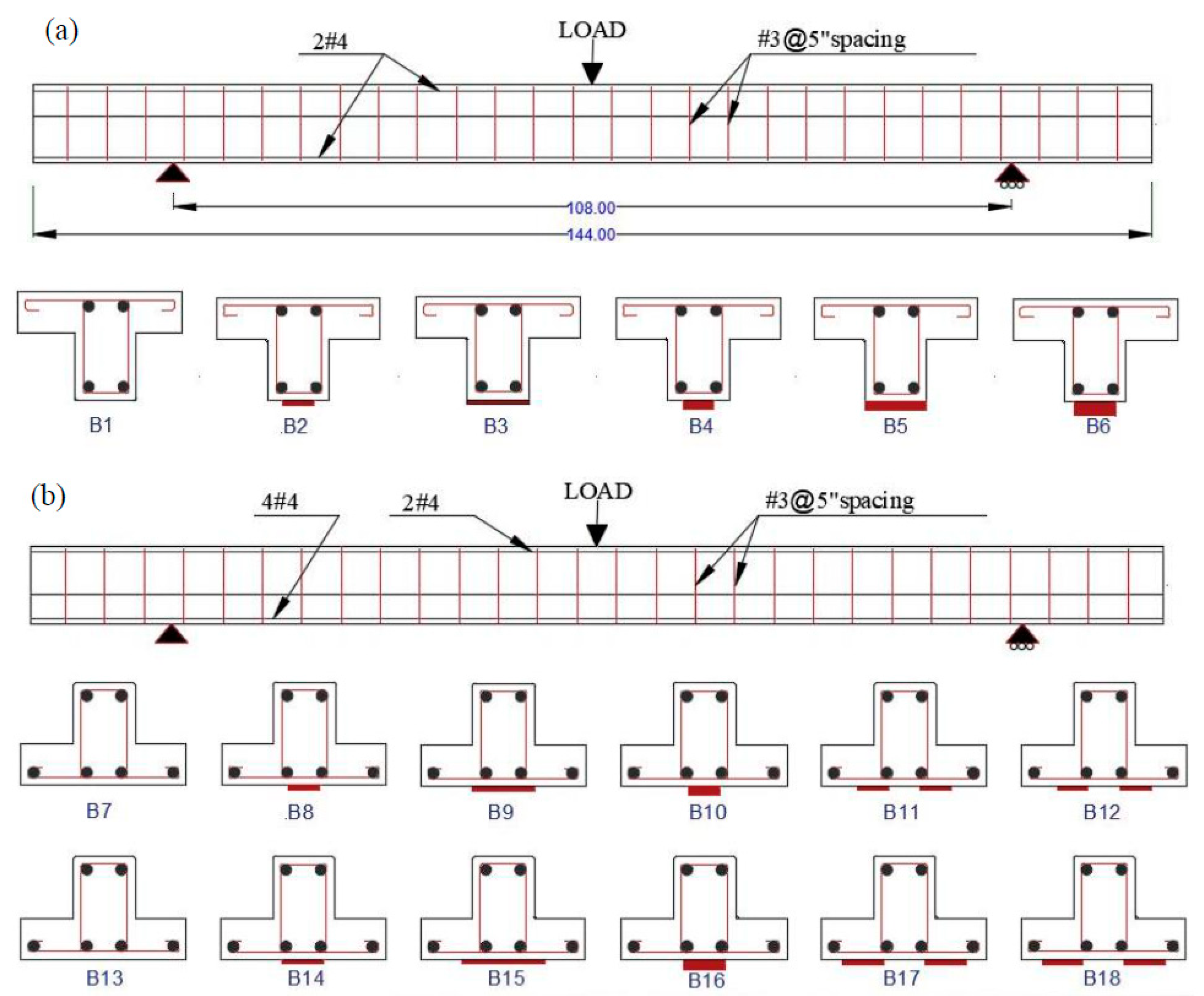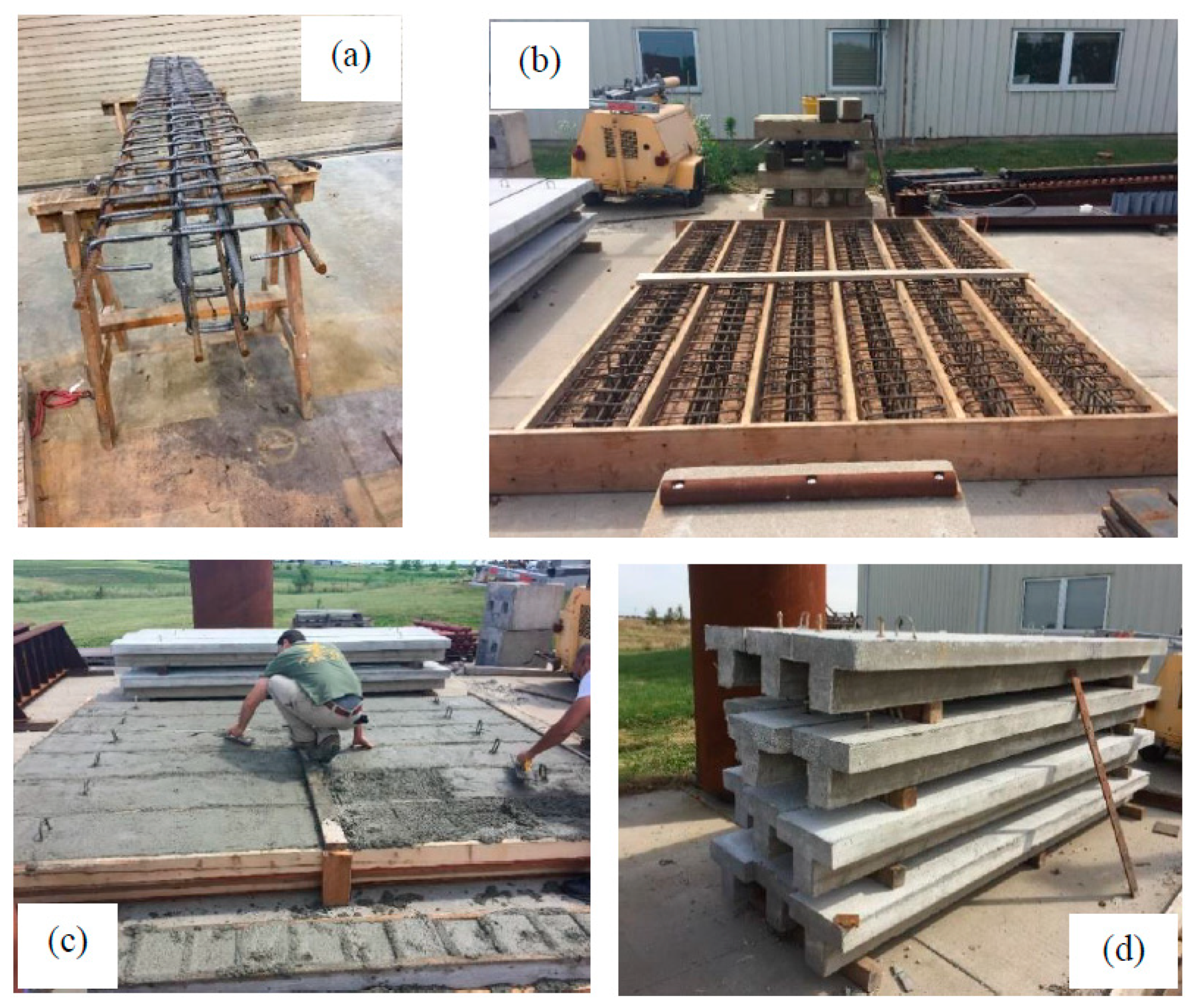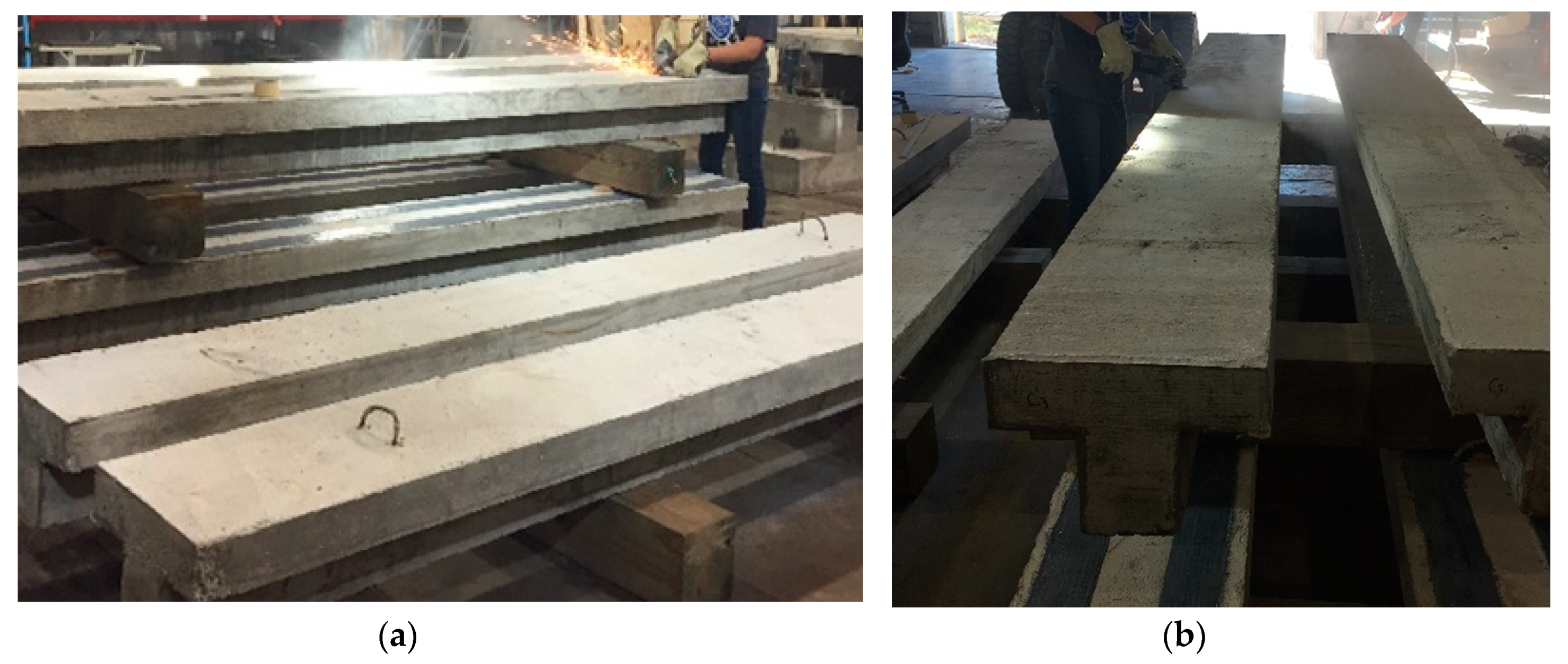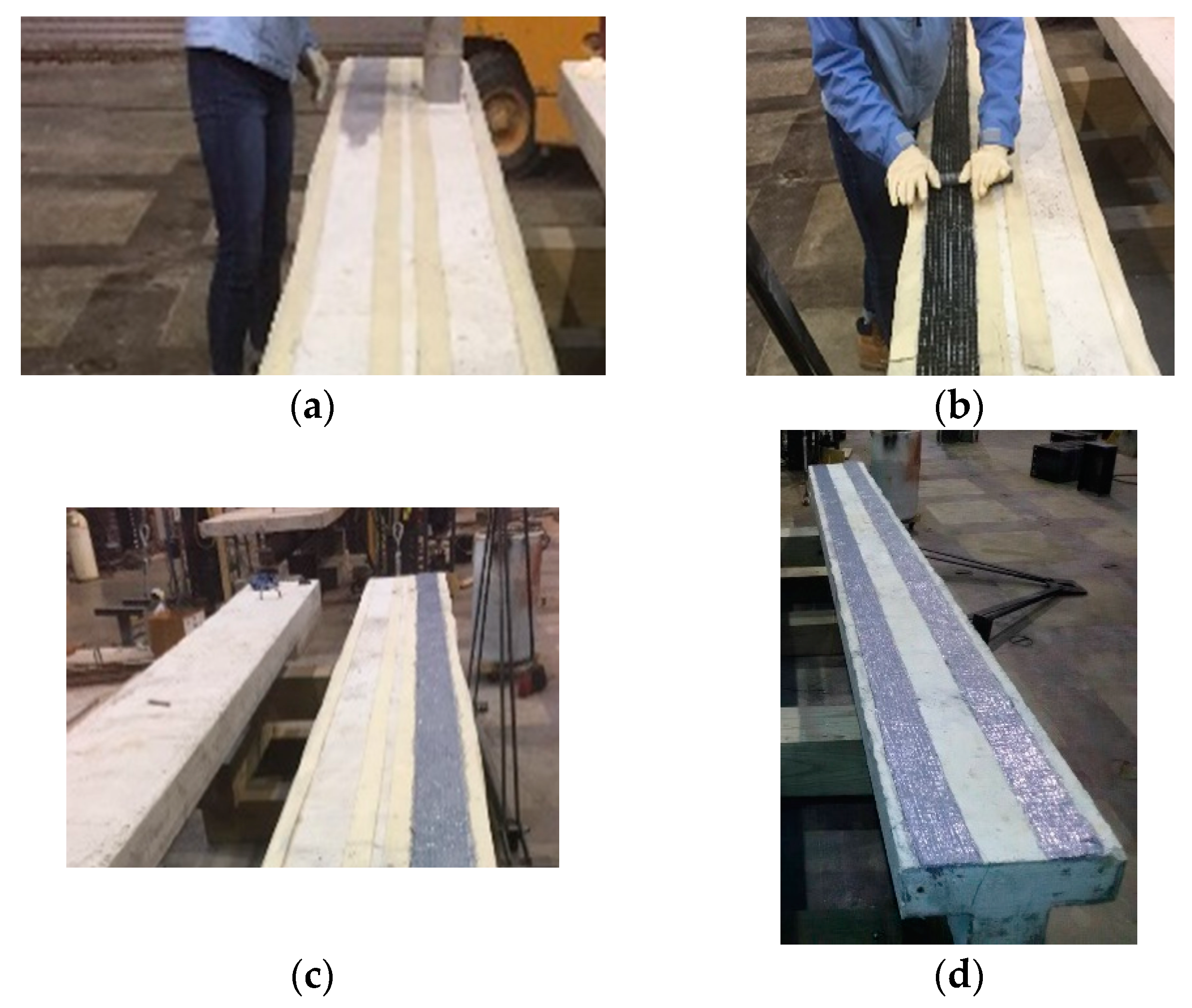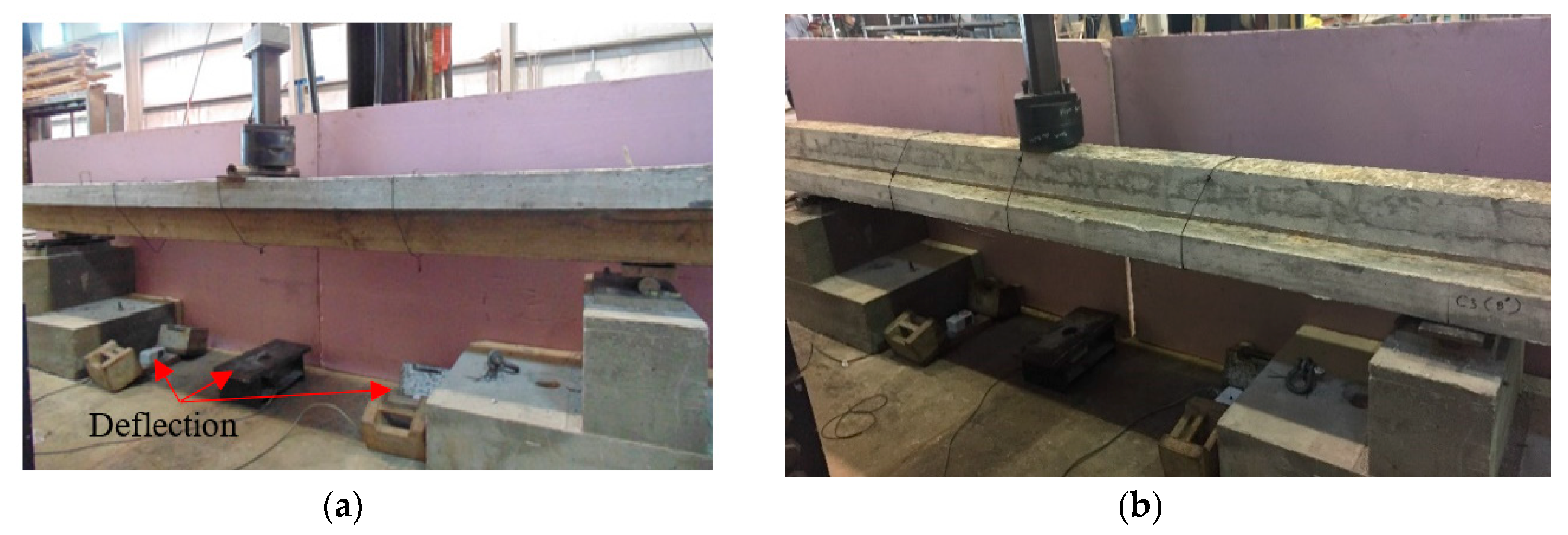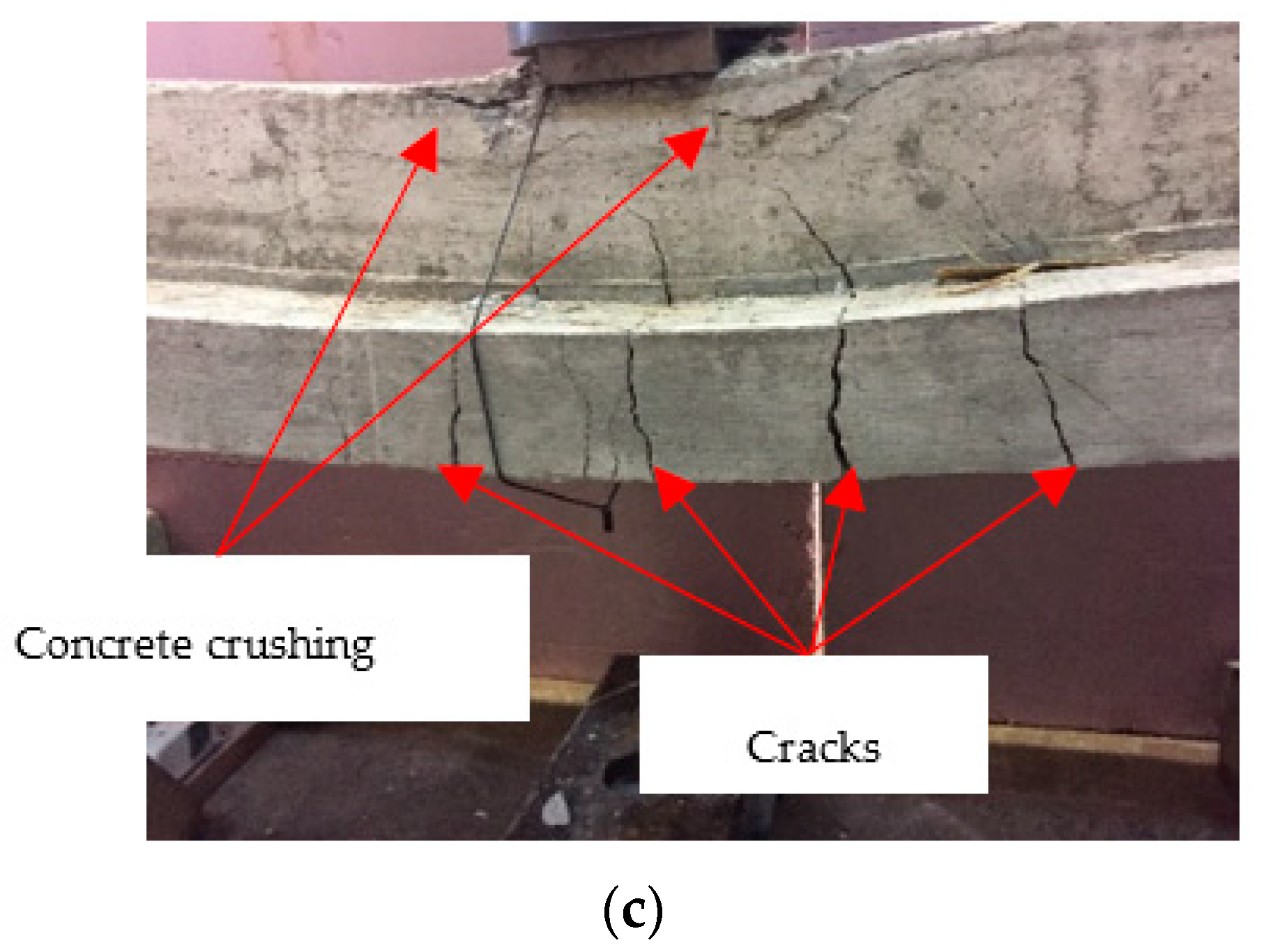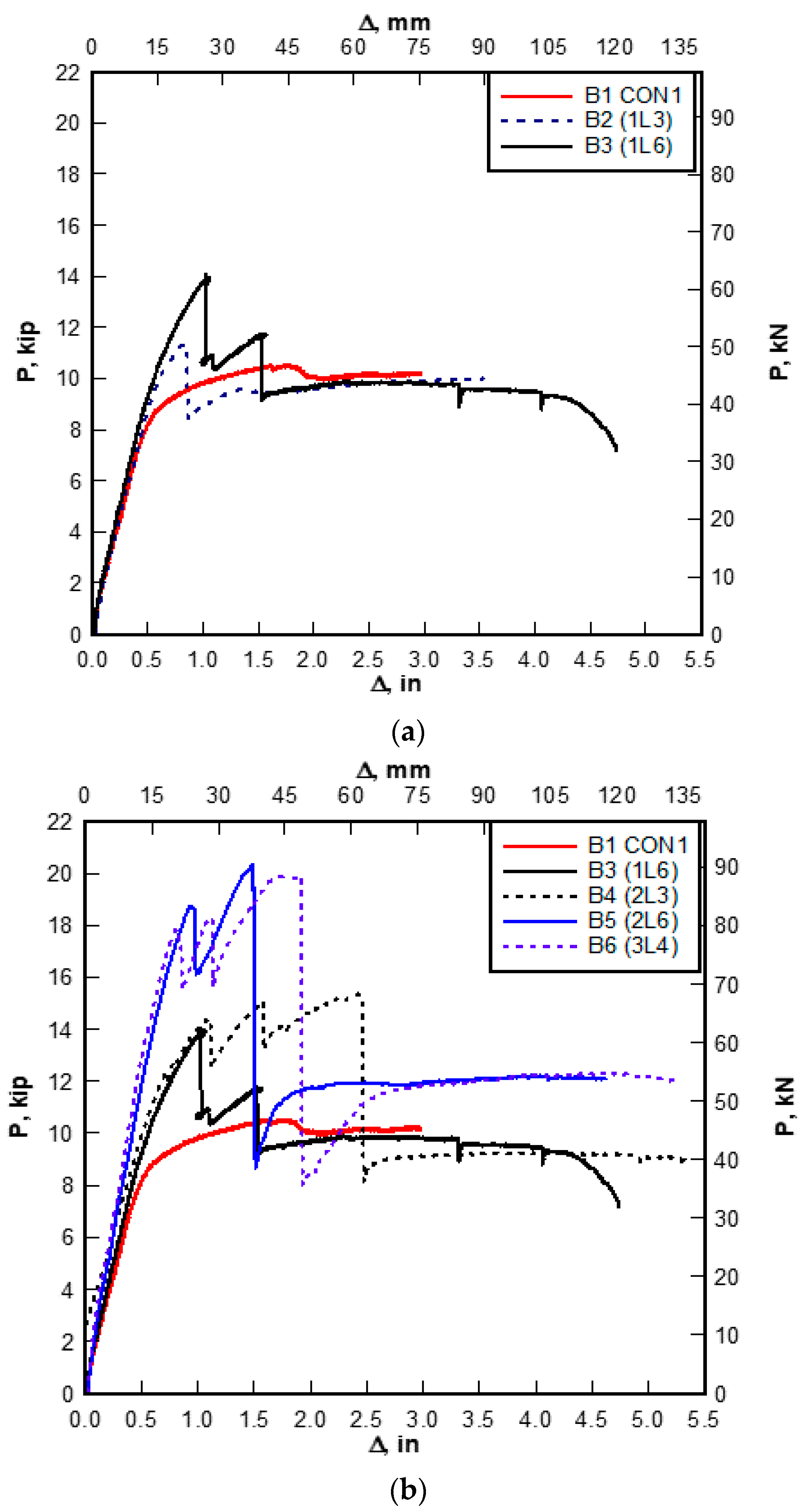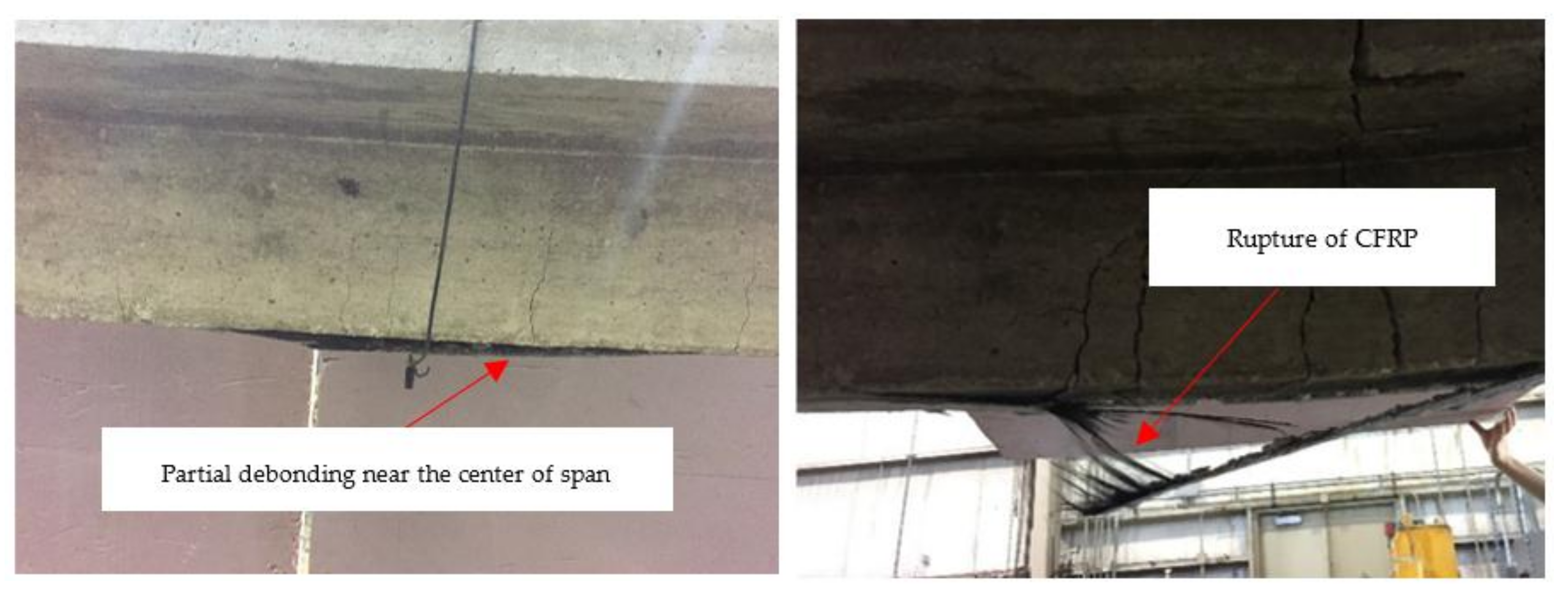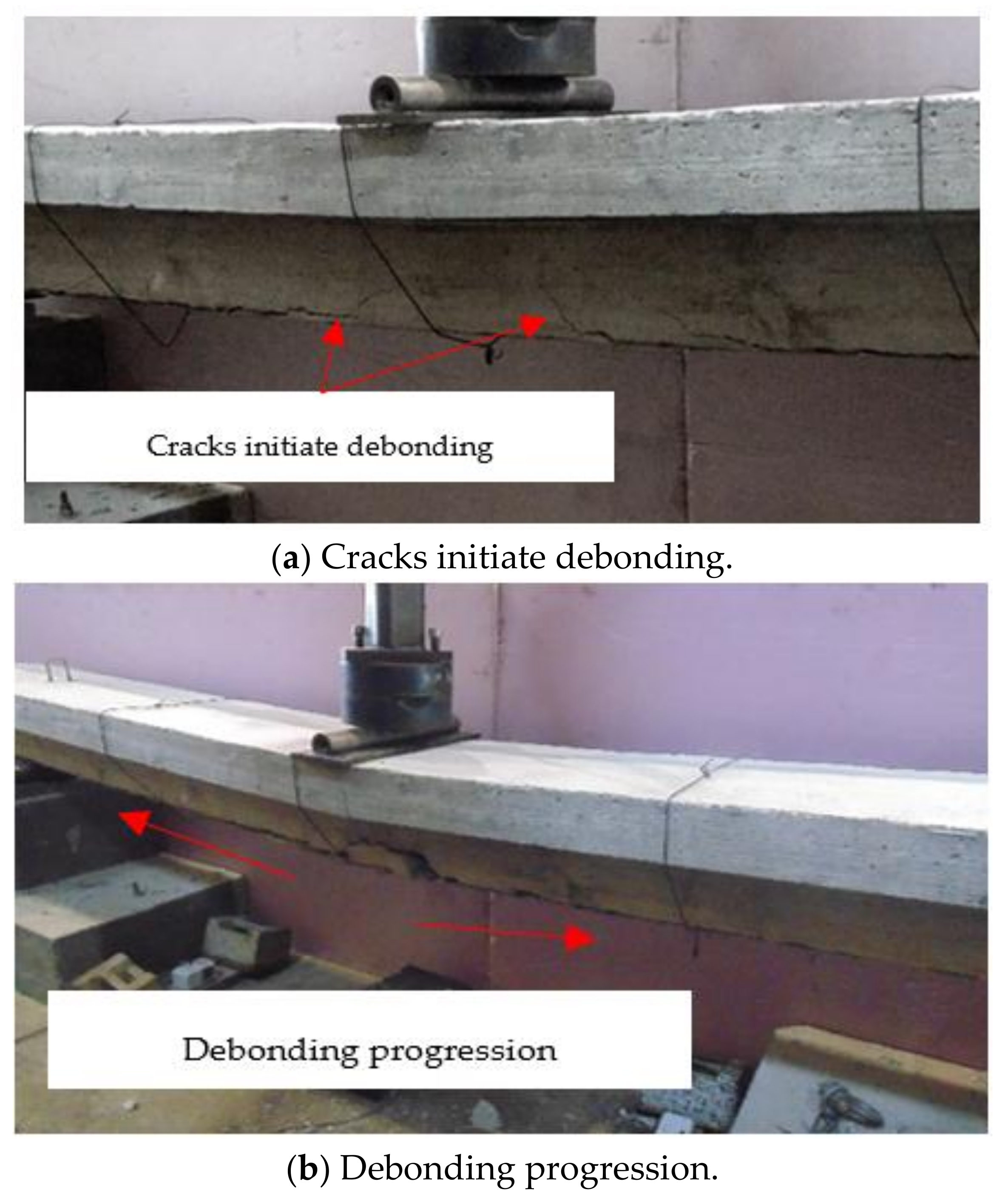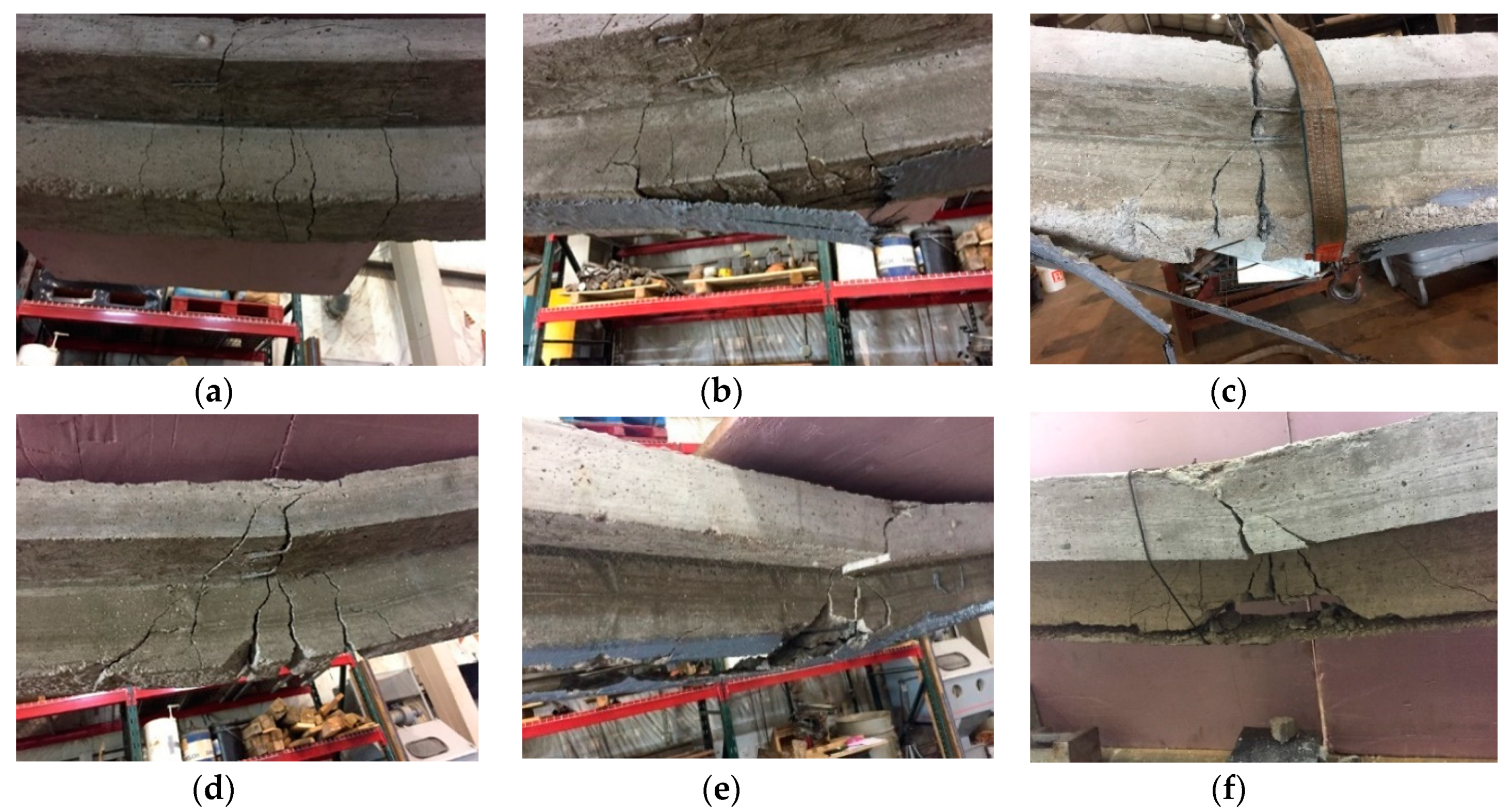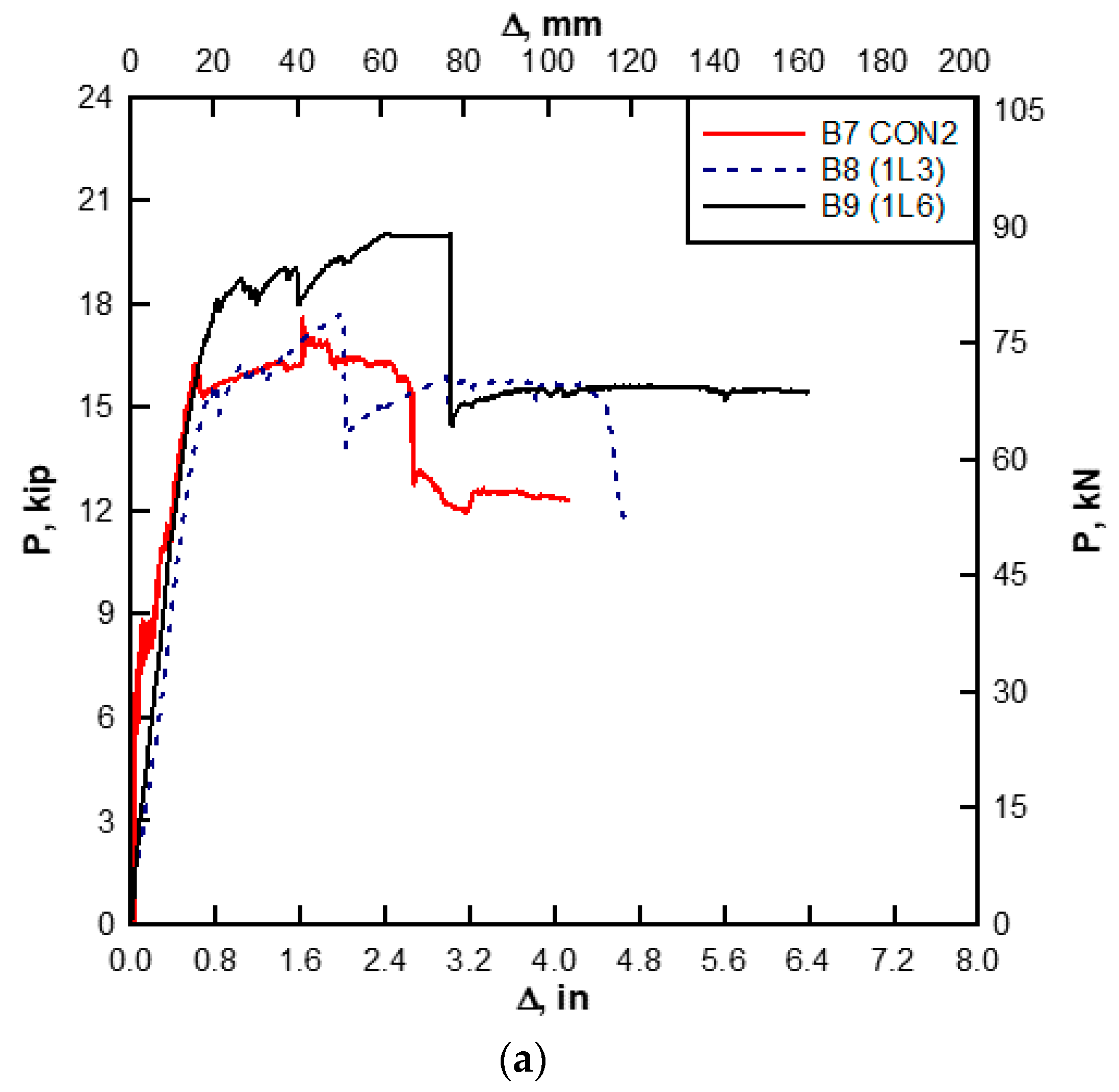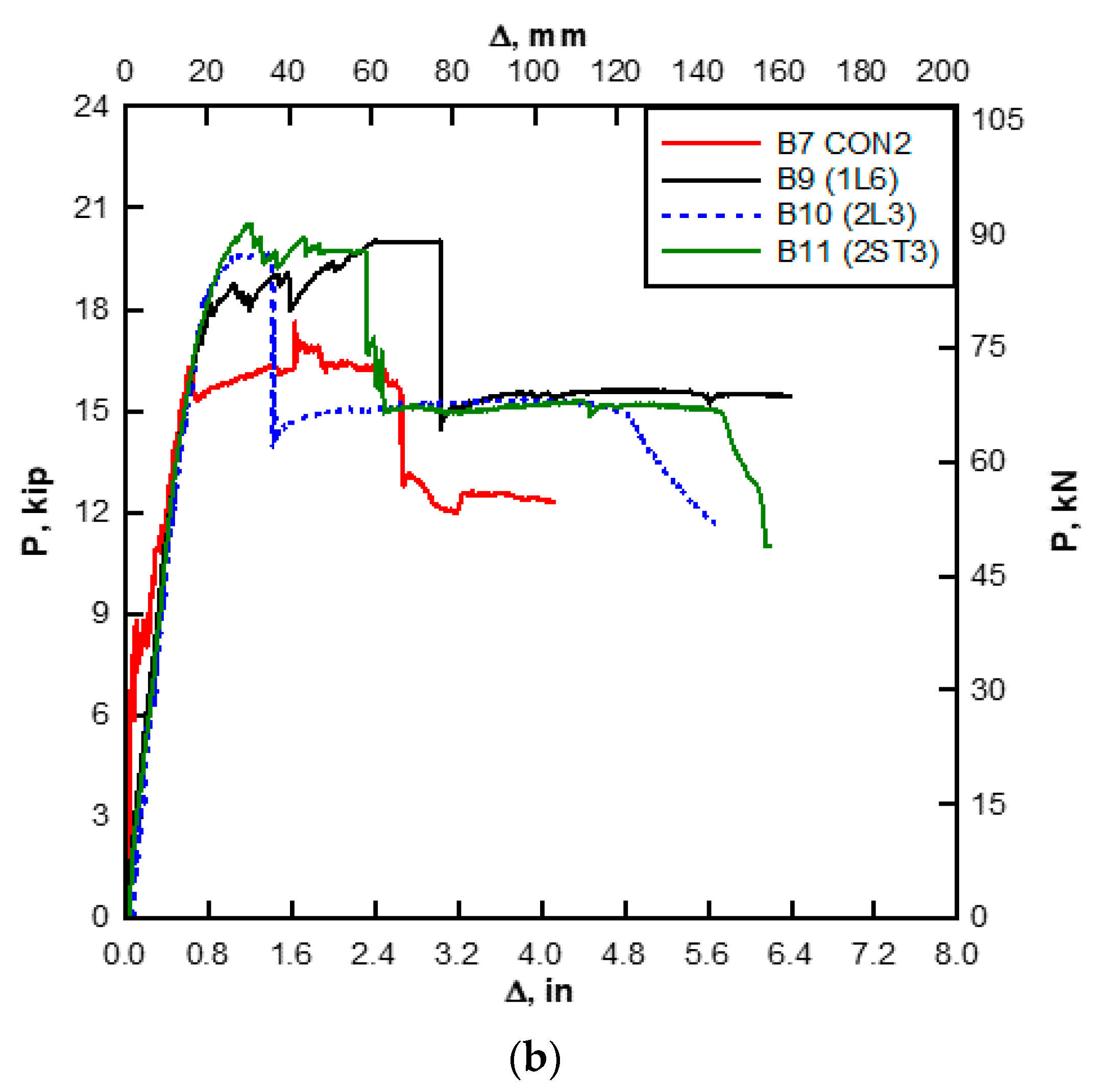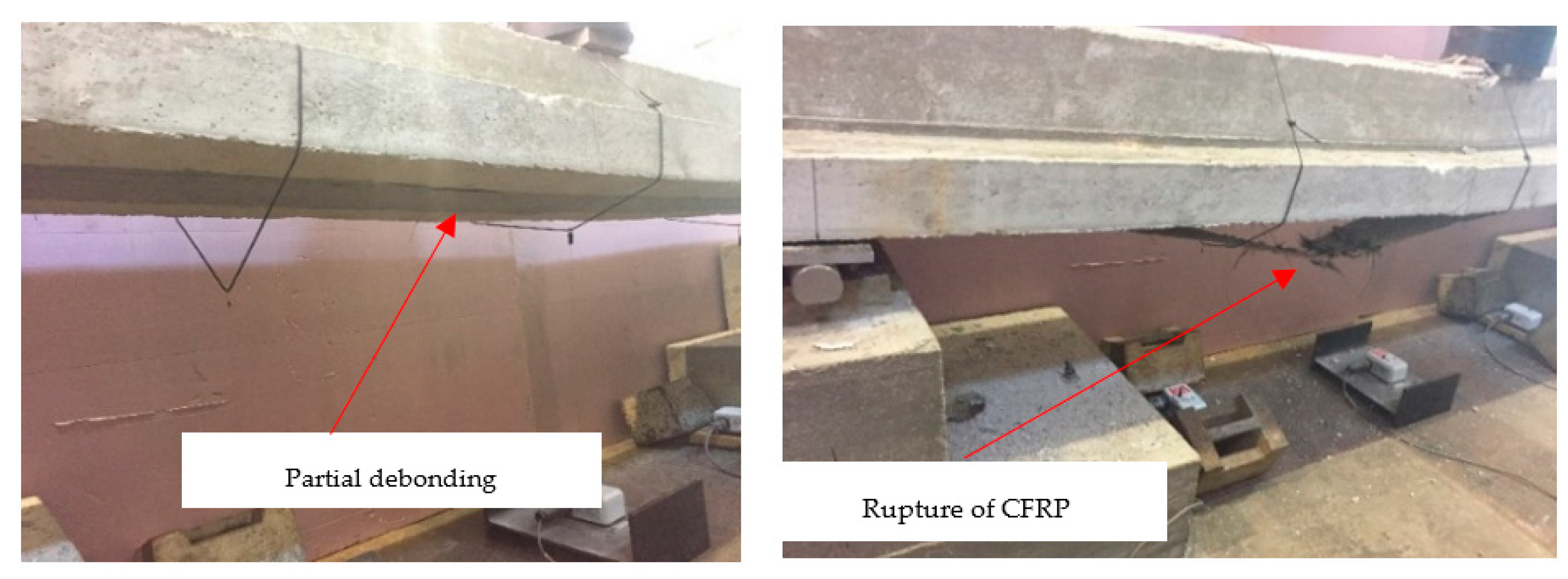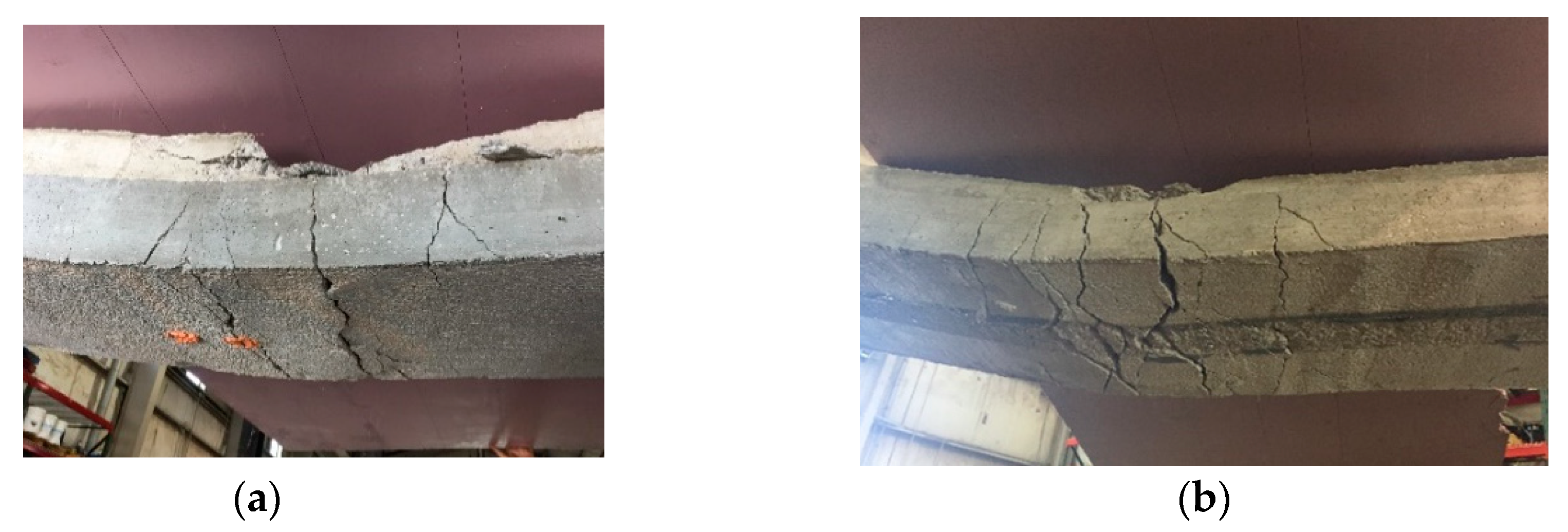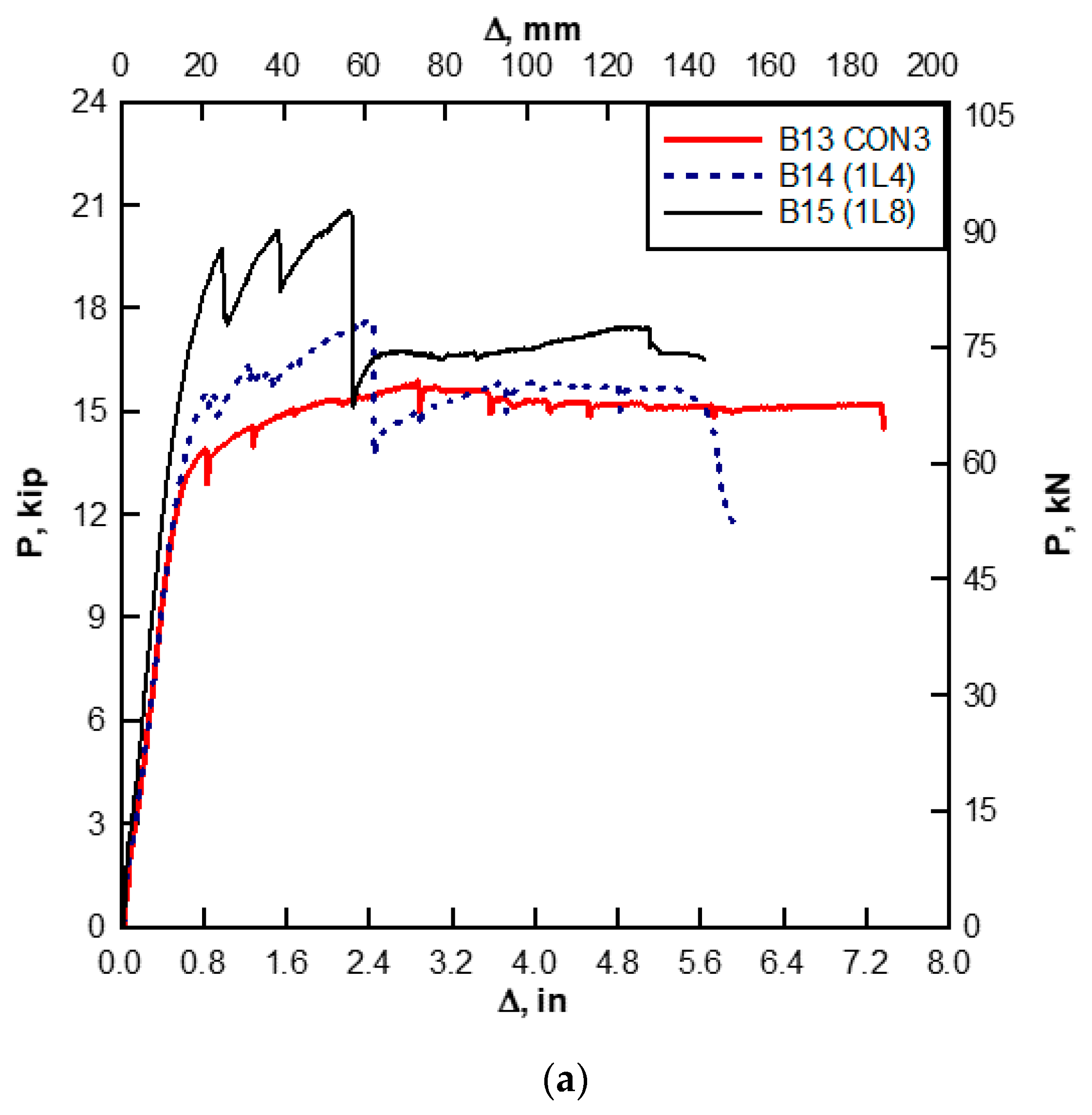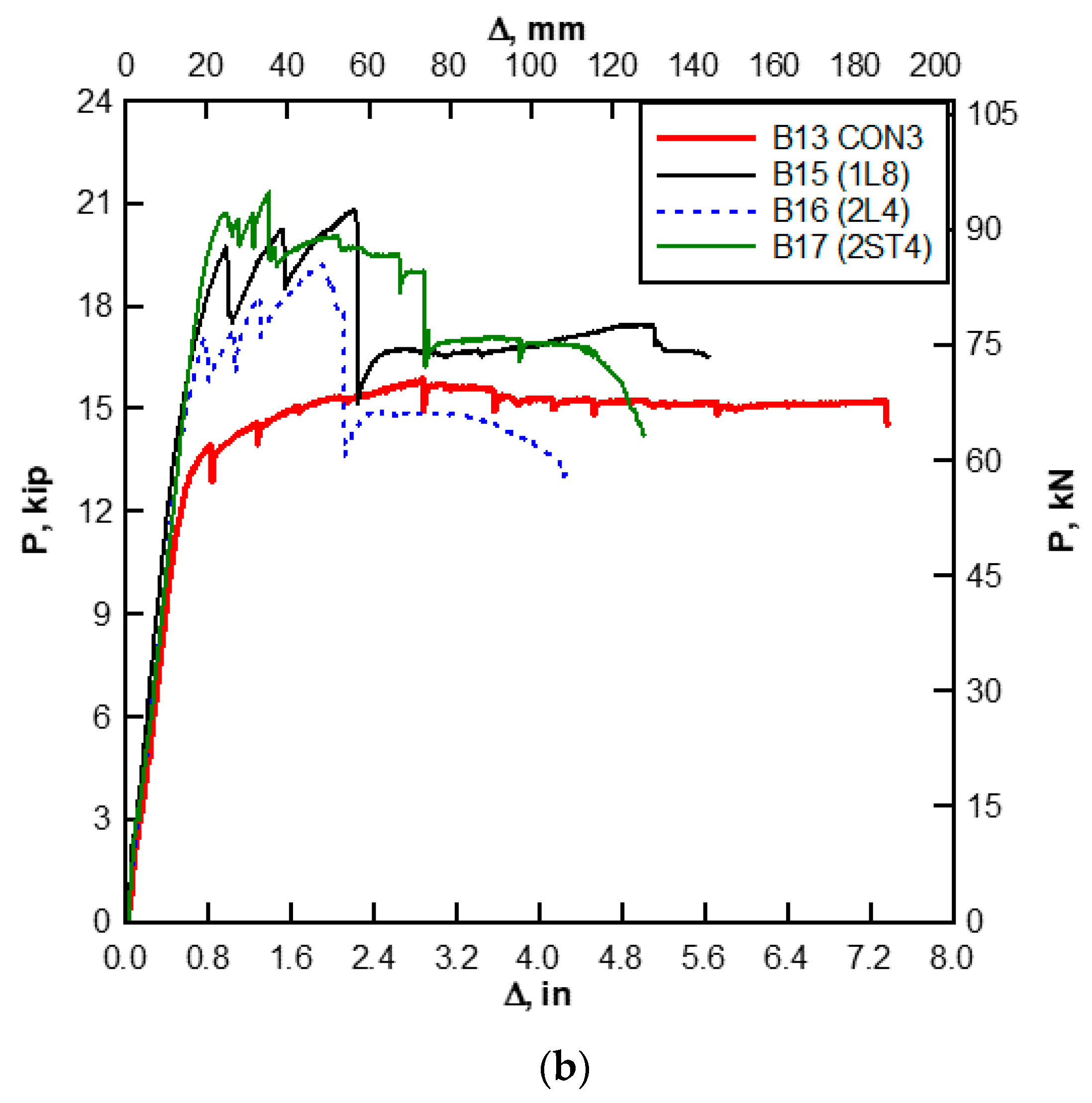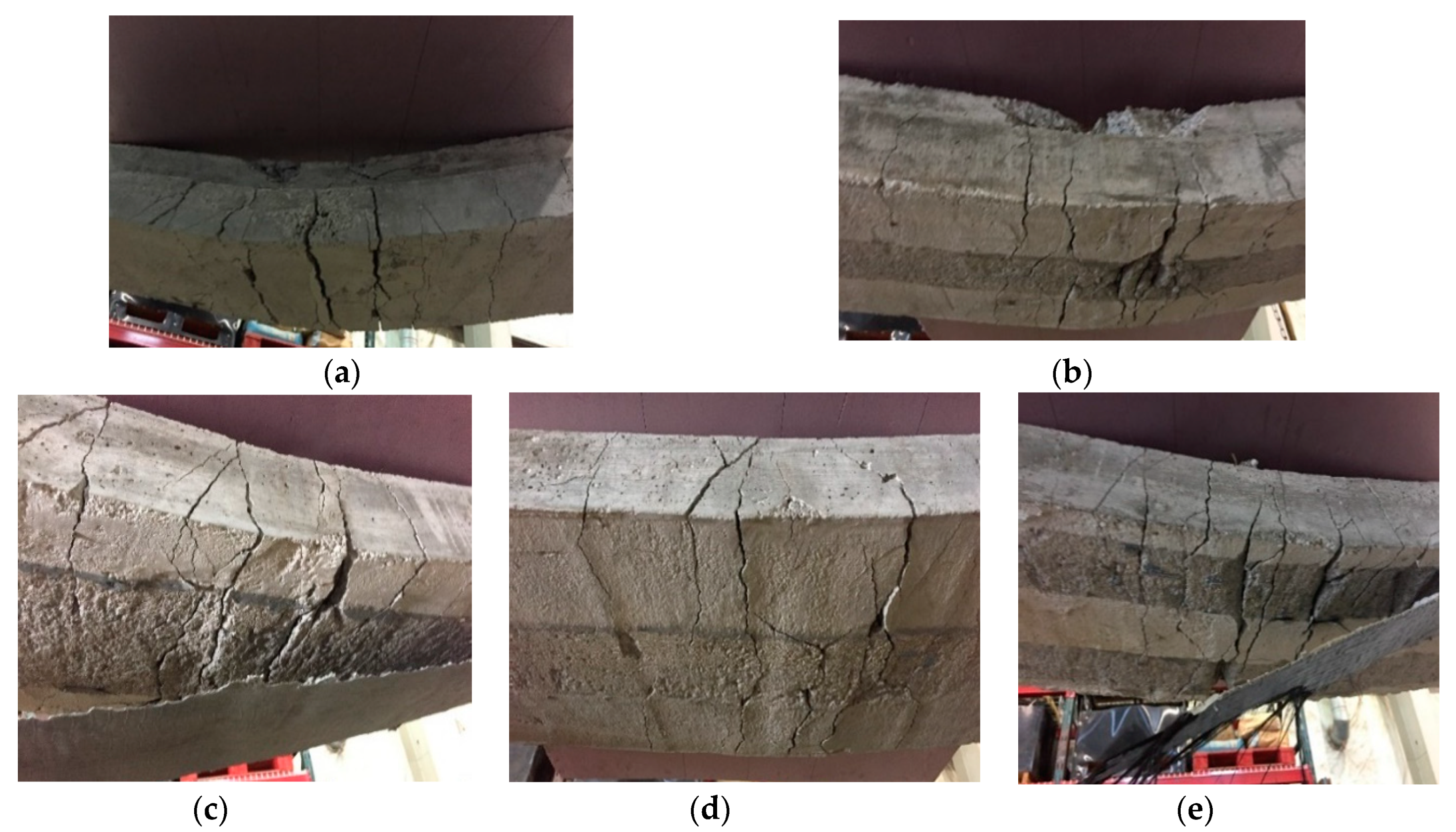1. Introduction
Externally bonded carbon fiber reinforced polymer (CFRP) sheets are considered as an effective technique for strengthening and repairing reinforced concrete (RC) beams [
1,
2]. The need to strengthen concrete structures for shear or flexure may arise because of initial design or construction errors, design code updates, deterioration during service life, fires, or earthquakes. The replacement of deficient structures may be considered; however, this requires large investments. Thus, strengthening the structures for flexure and shear has become one of the favorite ways for improving the load-carrying capacity and prolonging the service life of concrete structures
. Several researchers [
3,
4,
5,
6] have investigated shear strengthening by using fiber reinforced polymer (FRP) sheets, ropes and other strengthening techniques such as using FRP or mortar jacket. Some of these studies provide promising results, as it changes the mode of failure from brittle to ductile failure; it was also found that the shear capacity of the strengthened beams was increased compared to the un-strengthened beams. Other researchers have studied the flexural strengthen of the RC beams; Lamanna, et al. [
7] proposed a new method for strengthening RC T-beam for flexure. They attached the FRP strips to the RC beams by using mechanical fasteners which was found to increase the moment capacity in addition to greatly increase the ductility of the strengthened beams. Chellapandian et al. [
8], investigated experimentally and analytically the effectiveness of different strengthening techniques in improving the flexure behavior of RC beams. NSM, external bonding (EB) strengthening with a CFRP sheet, or hybrid strengthening, which uses a combination of NSM CFRP laminate and EB CFRP confinement, were tested. It was found that hybrid FRP strengthening significantly increases the capacity of the strengthened beams. Also, it was found that beams strengthened with hybrid FRP strengthening showed higher energy absorption capacity than other strengthened beams.
Strengthening the negative flexural region of concrete members can be more challenging than strengthening the positive region. Jumaat et al. [
9] addressed some practical problems for strengthening the negative moment region of a continuous span, which is considered a critical zone due to the presence of large moment and shear at the same location. The presence of the columns at such locations prevents the application of the CFRP system over the web portion of the beam. In addition, the use of other strengthening techniques, such as thick steel plates bonded to the floor surface, will raise the floor level, which can be undesirable.
According to Akbarzadeh et al. [
10], many in
-situ RC beams are of continuous construction; however, little research has studied the behavior of continuous beams with external reinforcement. Ashour et al. [
11] conducted an experimental study on reinforced concrete continuous beams with different arrangements of steel reinforcement and external CFRP reinforcement. The specimens were designed to fail in flexure. The modes of failure observed were laminate rupture, laminate separation, and the peeling failure of the concrete cover attached to the composite laminate.
Aiello et al. [
12] studied the behavior of RC continuous beams strengthened with CFRP sheets at only negative or positive moment regions, and compared the results obtained to the RC beams strengthened at both negative and positive moment regions. Although the control beams failed by flexural, the failure of the strengthened beams occurred by the debonding of the CFRP sheets along with concrete crushing. It was found that, when the strengthening was applied to both negative and positive regions, the ultimate load capacity of the beams was high. About 20% of moment was redistributed by adding external CFRP sheets in the positive region.
Maghsoudi et al. [
13] investigated the behavior and moment redistribution of reinforced high-strength concrete (RHSC) continuous beams strengthened with CFRP. The test results showed that, by increasing the number of CFRP layers, the ultimate strength increased. On the other hand, ductility, moment redistribution, and the ultimate strain of CFRP sheet decreased. In addition, it was observed that by increasing the number of CFRP sheet layers, the failure mode was change from tensile rupture to CFRP debonding. It was also concluded that limiting the end debonding was achieved by using end U-straps but did not prevent intermediate span debonding.
Akbarzadeh et al. [
10] performed an experimental program to study the flexural behavior and moment redistribution of RHSC continuous beams strengthened with glass and carbon fiber reinforced polymer (GFRP and CFRP) sheets. It was shown that, by increasing the number of CFRP sheet layers, the ultimate strength increased, while ductility, moment redistribution, and CFRP strain decreased. By using GFRP sheets, it was observed that the loss in ductility and moment redistribution can be achieved with no significant increase in the ultimate strength.
Akbarzadeh et al. [
14] studied the experimental behavior of six RC continuous two-span beams strengthened with externally bonded FRP sheets at the negative and positive moment regions. The beams were loaded with a concentrated load at the middle of each span. Different types of FRP (CFRP or GFRP or CFRP/GFRP) were used. The main parameters investigated were the type of FRP and the number of FRP layers. Three different failure modes were observed for the tested beams, and the test result showed that, by increasing the number of FRP sheet layers, the failure mode varied from tensile rupture to debonding of FRP sheets.
Rahman et al. [
15] presented a technique for applying CFRP laminates for strengthening the negative moment region of continuous T-beams considering the constraints caused by the column. It was concluded that the proposed method of CFRP application was easy and effective. Rahman and Jumaat [
16], evaluated the proposed method of the application of CFRP laminate for strengthening the tension zone of RC T-beams, and the effect of varying the length of the strengthening laminates. A total of three RC T-beams were tested, and it was found that the load-carrying capacities of the tension zone of the strengthened beams were increased by about 50% compared to un-strengthened beams. The length of the CFRP laminate recommended did not prevent the end peeling, although it increased the load capacity of the RC T-beam.
It can be concluded from the previous studies that the number, type of strengthening techniques, and the length of the CFRP layers impact the strength and ductility of the strengthened continuous beams; however, the effect of using different configurations and widths of the CFRP sheets on the response of strengthened continuous RC T-beams in the negative and positive flexural regions has not been fully investigated. Therefore, in this paper, the effect of CFRP configurations, such as the use of one-layer, multiple layers, or multiple strips, on the ultimate capacity and ductility of the strengthened beams were investigated experimentally.
5. Conclusions
In this paper, the experimental investigation of strengthening RC continuous beams were presented. Eighteen T-beams were cast: 12 were inverted and six were non-inverted. Different CFRP widths were considered, and different strengthening configurations with the same area of CFRP were investigated. The use of one-layer, multiple layers, or multiple strips was evaluated to investigate the effect of these configurations on the ultimate capacity and ductility of the strengthened beams. Below is a summary of the main conclusions of this study.
For the non-inverted T-beams, the ultimate load capacities of the CFRP-strengthened beams were enhanced by 4% to 90% compared to the control beam depending on the area and configuration of the CFRP strengthening. Also, using multiple layers of CFRP sheets enhanced the strength of the beam and improved the post-ultimate response of the beam compared to beams strengthened with a single layer. In addition, using multiple layers increased the stiffness by 6% to 46%, depending on the area of the CRPF used. A slight increase in stiffness was observed when using multiple layers compared to a single layer with the same area of CFRP. Using multiple layers of CFRP enhanced the toughness of the beams by about 30% compared to the ones using a single layer of the same area of CFRP. It was also found that non-inverted CFRP-strengthened T-beams experienced multiple strength peaks and drops during testing until complete failure. This was attributed to the debonding of CFRP associated with the concrete cracks that developed during test progression. This resulted in added ductility to the tested beams before the ultimate failure was reached.
For inverted T-beams, representing negative bending of continuous beams, the load enhancement ratio ranged from 2% to 35%, depending on the area and configuration of CFRP. It was also found that, although the increase in strength when using narrow CFRP strips was small, the enhancement to ductility was more apparent. The experimental results indicated that, by applying a single layer of CFRP as a wide strip or single-layers, multiple narrow strips resulted in improved strength and a ductility performance that was better than when applying CFRP in multiple layers of the same area of CFRP. This can also provide more desirable modes of failure than when applying CFRP in multiple layers. It was observed that debonding between CFRP and concrete occurred at various stages of the testing before the ultimate failure was reached. This debonding was attributed to the flexural cracks in concrete, which provided additional ductility to the tested beams. In addition, the ultimate load and stiffness for the inverted T-beams strengthened with CFRP increased as the width-of-CFRP to the width-of-concrete ratio increased. Little enhancement in beam capacity was obtained when the CFRP width-to-concrete width ratio was less than one fourth. For these beams, it was also found that, as the compressive strength of concrete increased, the addition of the CFRP improved the beams ductility.
Comparing the experimental results with the analytical prediction, they were found to be very close. It was found that analytical prediction can safely predict the nominal strength of the strengthened beams with slight differences between them.
The results of this research show that using multiple layers of CFRP sheets enhanced the post-ultimate response of the T-beams. In addition, using multiple layers of CFRP enhanced the toughness of the non-inverted T-beams, whereas this was reduced for inverted T-beams.
